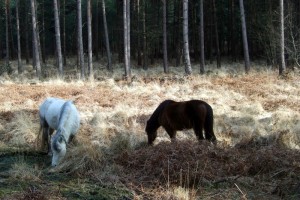At the foot of bustling southern England is a rare and precious medieval mosaic of a landscape, named Britain’s smallest national park in 2006. I found the New Forest not very different from how it was when William the Conqueror set it up as his hunting haunt. My list of things not to miss includes a 900 year old crime scene, the town where Alice (of Wonderland fame) settled down, free range grazing pigs, and the yard where they built the boats for Nelson’s navy.
Green tour
This unique and majestic tract of ancient trees and stately open spaces lawns, mixed up with fragile, heather-covered heaths, threaded with tinkling streams, was declared England”s smallest national park in 2006. We, like nine visitors out of 10, arrived by car. You”re welcome to drive around, to stop at set car parks. But there are greener alternatives, such as travelling by train to one of the four stations – Ashurst, Beaulieu Road, Brockenhurst and Sway. The forest is in daytrip range of London, S.Wales, even the Midlands. Then the easiest and laziest way to see the forest, and promote its tranquillity, is by hop-on, hop-off open-top bus (19 June to 12 September). The circular meander takes in many key places. Stops include Brockenhurst, with its elegant Georgian buildings; and Lymington, for its cobbled quay, and glimpses to the Solent. £9.
Alice’s wonderland
Whatever became of Alice Liddell, the little girl who inspired Lewis Carroll’s Alice’s Adventures in Wonderland? She moved on from mad duchesses and grinning Cheshire cats, and married Reginald Hargreaves in a society wedding in Westminster Abbey in 1880. As Alice Hargreaves, she led a quiet life in Lyndhurst, the unofficial capital of the New Forest, playing down her celebrity. (The house – she sold her original copy of “her” book for its upkeep – is gone.) She died in 1934. Her ashes were buried in the graveyard of St. Michael and All Angels Church, where there is a memorial to her two sons killed in World War I. In this imposing Victorian Gothic church, visible from afar in the forest, there’s a fresco by Lord Frederick Leighton, and fine Pre-Raphaelite windows by William Morris and Edward Burne-Jones.
Graze anatomy
Where else would you see a small herd of cows, more appropriate to India, browsing free over an unfenced village green, as we did in Beaulieu, close to the National Motor Museum? And the ponies. We would suddenly come across one, standing still and nonchalant in the middle of the road. (This is why the forest has a blanket 40 mph speed limit.) It was probably trying to work out where next in 200 unrestricted square miles of forest it might head. In September they are joined by pigs, set loose to munch on the acorns on the wide, natural lawns. These wandering animals – there are donkeys too – are a remarkable link with history. They are owned by ”commoners”, local people who inherit the right to let their animals graze at will. For centuries they have played an essential role in keeping down the scrub, letting the rare forest nature flourish. There’s only one rule: don’t feed them.
Super spin
For me, simply the best way to enjoy the park’s remarkable landscape and nature is on a bike. Find specialist companies hiring bikes, by the day or longer, on www.new-forest-national-park.com. They supply all the equipment and route advice you need – and yes, they know where the best pubs and tea rooms are. There are many miles of quiet roads, threading through the forest”s ancient heart, many with no traffic at all. There are high views as far as the Isle of Wight, shady valleys, and mysterious ways deep into the trees. Stay alert and you may have the wonderful bonus of coming unexpectedly upon the local prestige wildlife. Look (and listen) for Dartford warblers in the gorse, and, most thrilling of all, nighjars at dusk. We once saw an adder, near our picnic spot, under an old oak. It was much more frightened than us.
History trail
We connected with the forest’s distant beginnings at the Rufus Stone, near Cadnam. It marks the spot where King William II was killed by an off-range arrow in 1100, not long after his father, the Conqueror, set the place up a royal hunting chase. (Or was it murder?) Another link with the past is the ancient Knightwood Oak, near Lyndhurst. The forest’s largest oak is a still thriving example of the ancient art of ”pollarding”, where wood is harvested without killing the tree. We followed forest history right through to World War II. In Lepe Country Park on the Solent, we toured the foundations of the huge units where they built Mulberry Harbours for the Normandy invasion. Download free podcasts, telling these and other stories, from the website below.
Quiet nights
We stayed in the ”Victorious”, a grand name for a hotel room, but very apt in The Master Builders. Henry Adams and his sons – the hotel is named after them – built this fighting ship for the navy in 1808 (and vessels that fought with Nelson at Trafalgar) on the placid little inlet we could see from our window. They continue the nautical theme in the foyer, where we walked under a parade of flags on our way to the excellent restaurant. This rambling, comfortable boutique hotel at Buckler’s Hard, down in the bottom SE corner of the forest, is one of the Hillbrooke Hotels’ distinctive small stable. You want quiet? Try this. On one side was a grassy road as wide as a Parisien boulevard. On another, the pretty Beaulieu River where globe-circling Francis Chichester tied up. In all other directions, the deep peace of the forest. The Master Builders – 0844 815 3399

